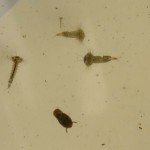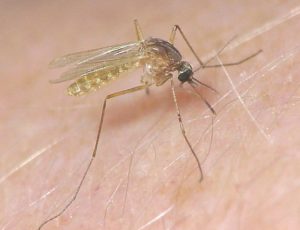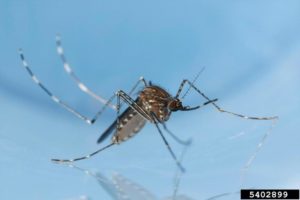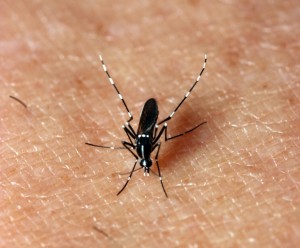General Information
There are approximately 175 species of mosquitoes in the continental United States. For management in and around schools, mosquito species can be divided into two types; nuisance species and vector species. Vector species can spread disease and thus require more vigilance than nuisance species. In Texas, we have four species of mosquitoes that are considered medically important; while many others fall into the nuisance category.
Mosquitoes are of concern in the school environment because many species are painful biters and/or are capable of transmitting diseases. In the United States, the threat of developing encephalitis from mosquitoes is far greater than the threat from other mosquito vectored diseases. Encephalitis, meningitis and other diseases can develop from the bites of mosquitoes infected with certain viruses such as West Nile, St. Louis encephalitis, LaCrosse (California) encephalitis, and Eastern equine and Western equine encephalitis. An effective control program will not eliminate all mosquitoes but will keep the population at a reasonable level and will reduce both nuisances and the risk for mosquito-borne diseases.
Identification
Adult mosquitoes are small and fragile, ranging in body length from 3 to 8 mm (vs. the much larger, non-biting cranefly. The mosquito’s head is small and globular with a large pair of compound eyes. Protruding from the head are long thin piercing-sucking mouthparts and a pair of antennae which are smaller on the female and feathery or bushy in the male. The thorax is deep but thin and the single pair of wings are long and narrow and held along the body when the insect is at rest. Mosquito wings characteristically have small scales along the veins and along the hind margin. The legs are long and thin. The abdomen is also long and thin. Mosquitoes can be many different colors (usually black, brown, or gray, but occasionally iridescent) with different patterns of strips and spots.

The larval stage of the mosquito is aquatic. The larvae are legless and spend a majority of time at the surface of the water.
All mosquitoes undergo complete metamorphosis-egg, larva, pupa, and adult. The larvae are commonly known as wigglers, and the pupae as tumblers. Mosquitoes require water for larvae and pupae to develop, although a moist substrate may permit development of the pupa of some species. Eggs of some species may survive long periods out of water, some purposely laid on dry areas prone to flooding, but all require water to hatch.
Larvae (wigglers) and pupae (tumblers) are found in still water, often resting at the surface. They breathe air and although they will dive down when threatened, eventually they will resurface. Larvae are 1 to 8 mm long, dark in color, legless, and have a round head, round thorax and elongated abdomen. They wriggle side to side to move through the water. Pupae are shaped like a comma, with their head and thorax encased together and the abdomen curled under them. They tumble in a somersault-like fashion to move through the water.
Most species are not strong fliers and avoid strong wind while other species (primarily saltmarsh and floodwater species) are capable of dispersing over a great distance. Many adult mosquitoes are active at dawn, dusk, or into the evening, but, some important pest species fly and feed during the day. The female mosquito requires a meal of vertebrate blood for egg development. Male mosquitoes do not bite and normally feed on plant juices.
 |
 |
 |
 |
| Southern house mosquito, Culex quinquefasciatus | Western Encephalitis mosquito, Culex tarsalis | Asian tiger mosquito, Aedes albopictus | Yellow fever mosquito, Aedes aegypti |
Suggested Thresholds
Outdoors – As determined by public health authorities, a landing rate of greater than 5 per minute, trap counts of greater than 100 per night, or several staff or student complaints.
Indoors – As determined by public health authorities, a landing rate of greater than 5 per minute, trap counts of greater than 25 per night, several staff or student complaints, or significant disruption of learning environment.
Monitoring, Inspection and Evaluation Methods
Integrated Pest Management calls for early detection and good record keeping in order to evaluate the efficacy of a control program. Complaints from staff and students can be one surveillance method. However, this is subjective and can be influenced by heightened awareness, hysteria, or the knowledge that a control activity was conducted.
More objective methods include larval and adult mosquito surveillance.
Larval surveillance is performed by examining likely habitats for larvae and keeping track of the number of larvae found. A sketch or plot plan of the school grounds is helpful in recording locations where surveillance may be needed. Larvae and pupae of common species are found primarily in standing water in artificial containers located around the school building itself. These sources can be inspected, and larvae and pupae captured if present. Tools for this can be a turkey baster or a light-colored ladle (which can be attached to a broom stick for a longer reach). Usually the record includes larvae per dip and the number and location of habitats examined.
Adult surveillance can be performed by trapping or landing count. A landing count involves a volunteer (preferably the same individual each time due to differing attractiveness between individuals) standing still and another counting the number of mosquitoes landing on him/her within a specific time period (1-5 minutes). Trapping is another method and requires the use of a trap or traps which can be acquired from a biological supply company or homemade. The trap(s) should be set in the same places, for the same amount of time, and in similar weather. For non-experts a propane-based trap can be a better choice, although the costs are higher, because little skill is required to properly set it and it can be run constantly with little maintenance while checked on a regular basis. (It should be noted that traps often attract many more mosquitoes than they capture and should not be set in close proximity to human or equine activity.
If mosquito-borne diseases are a concern in your area, contact the local mosquito control district or health agency. Adult mosquitoes also may be carefully captured and preserved in between tissues in a small box and then kept frozen for identification by mosquito specialists. State or county public health agencies, or pest control companies in mosquito-prone areas may have specialists on staff.
Some mosquitoes found around marsh habitats are capable of flying many miles, in which case, control may need to be area wide. If a school is near such sources and intervention is necessary, efforts will have to be coordinated with county or state mosquito abatement authorities. Refer to your state departments of health for updates on medically important mosquito species in your area.
In general, identification and elimination of mosquito oviposition (egg laying) sites is more effective and less hazardous than attempting to eliminate adults. These sites include any water that stays still, lacks predators (like fish), and lasts for more than a few days. Some examples are: rain barrels, tires, tarps, trash, take-out food containers, storm drains, and clogged roof gutters. The Asian Tiger Mosquito (Aedes albopictus) is especially well adapted to using any small body of water, including bottle caps, cut off fence posts, bamboo ends, and corrugated drainpipe. Elimination of such waters on a weekly basis preempts the emergence of adults. Adults, on the other hand, once flying, are difficult to control without using chemical means. Adult control methods such as traps, “bug-zappers,” etc. may not effectively reduce mosquito populations. Exclusion of mosquito adults from buildings is more feasible and can be accomplished with screens, closed doors, and fans. Keep in mind that during warm weather, mosquitoes can breed in any water that lasts more than four to seven days, depending on the temperature.
Nonchemical Control Measures
Sanitation/Cultural Control Measures is source elimination and habitat manipulation:
- Identify anything outside that can hold water such as plastic bottles, cans, containers, and such. Dispose of items, turn containers over, drill holes in containers or dump out water weekly.
- Turn over wheelbarrows and other water-holding tools when not in use.
- Do not allow water to become stagnate in birdbaths, ornamental pools or other outside areas.
- Regularly inspect and clean out gutters and drainpipes.
- Cover dumpsters, trash and recycling receptacles to prevent water accumulation
- Be aware of nearby piles of used tires, which have become important mosquito oviposition sites. Remove old tires or have holes drilled in them to drain water.
Eliminate adult resting sites (tall grass, brush, pines, and other vegetation) - Cut back or remove dense brush and other vegetation from around buildings
- Keep grassy areas mowed
- Promote natural breezes to discourage mosquito occurrence
- Alter landscaping to eliminate standing water
- Angle corrugated drainpipes to allow total drainage.
Physical/Mechanical Control Measures
- Make sure window and door screens are in good repair
- Place fans at doorways if mosquitoes are still entering buildings
- Netting/screening for beds, porches, and open door areas.
Biological Control Measures
Biological organisms used to control mosquitoes include predators of larvae and adult mosquitoes, or formulations of naturally occurring mosquito parasites or diseases. The latter are registered by EPA as pesticides.
Many naturally-occurring fish are predators of mosquito larvae. Fish of almost any kind will eat mosquito larvae, including goldfish. The killifish species Gambusia holbrooki and G. affinis (Cyprinodontidae) are native to southern and eastern US and have been used quite successfully for larval control in many situations. However, when translocated to new environments, these fish may compete unfavorably with local fish and other aquatic species. Thus, Gambusia spp. should be used selectively in self-contained water bodies that are not fed or drained by natural waterways. Self-contained waters can include ornamental ponds, abandoned pools, mine pits, livestock waterers, fountains or large birdbaths.
Chemical Control Measures
Repellents
If students or staff will be in areas of high mosquito activity, advise parents/staff of this fact so that precautions can be taken. Insect repellents are considered to be pesticides by the EPA and as such, are not appropriate for application by staff to students. However, school district policy can direct how repellents can be used on school property, consult with your local health authority for any type of restrictions in your area.
Pesticides
Larvicides (which target mosquito larvae) are typically more effective and target-specific than adulticides (which target mosquito adults). Habitat modification is more permanent and preferred to pesticide use where possible. Larvicides include bacteria specific to mosquito and aquatic fly larvae (bacillus sphaericus or bacillus thuringiensis israelensis), insect growth regulators [IGR’s] (methoprene), and chitin synthesis inhibitors. Other larvicides include several non-petroleum oils and monomolecular films. Most control can be accomplished with bacterial, IGR, or oil based insecticides.
The timing of larvicide applications depends on the product. Bacterial toxins must be consumed by the larvae and are usually applied well before the fourth molt, while they are still “wrigglers.” IGRs must also be applied before the pupae stage to upset the molting process. Chitin synthesis inhibitors are effective throughout the entire larval life cycle. These products are usually in pellet or dunk form. The dunks can be applied by hand, while the pellets can easily be distributed with a hand crank seeder/fertilizer. A new technique for applying liquid bacterial toxins and IGR’s is to use a fog producing apparatus to distribute the product into numerous containers (such as a dumping ground or tire pile). Monomolecular films prevent the insect from remaining at the surface of the water by reducing surface tension, causing the larvae and pupae to drown. Non-petroleum oils kill larvae and pupae by suffocation. Oils and monomolecular films kill larvae at all stages and can be applied whenever larvae are present.
Adulticides are most effective only when the source of the mosquitoes are also addressed. Pesticides targeting mosquito adults can be applied from the ground or air. Pesticides can be applied as a liquid barrier spray or as a fog. Barrier sprays require less specialized equipment and are performed by applying liquid pesticide to resting areas within an area and around the perimeter. These pesticides dry and then kill insects on contact for a few days to a few weeks after application. A barrier spray requires vegetation or other structures around the perimeter in order to effectively defend an area. Care must be taken to avoid flowers for the sake of bees. Fogs are often applied as ultra-low-volume sprays in which small amounts of insecticide are dispersed either by vehicle-mounted equipment or from fixed-wing or rotary aircraft over a large area. Pesticide droplets must contact the mosquito to be effective, so fogging is often done around sunset when mosquitoes are most active. Fogging for mosquitoes is an activity often undertaken primarily by municipality or county agencies, school districts should consult with their local mosquito district to coordinate efforts during major mosquito outbreaks.
An effective control program will not eliminate all mosquitoes but will keep the population at a reasonable level and will reduce the risk for mosquito-borne diseases. Most schools are under the umbrella of a local or state-run mosquito mitigation program. Often these programs, are already performing mitigation activities in the area and can complement a school’s IPM strategies. They can identify the pest species to help target the correct sources. They know what diseases are prevalent to help determine thresholds. They know what is happening in the surrounding area and can help a school determine if an infestation is self-made or part of a larger problem.
Compiled from publications by John Hopkins, Mike Merchant, Loyal Hall
